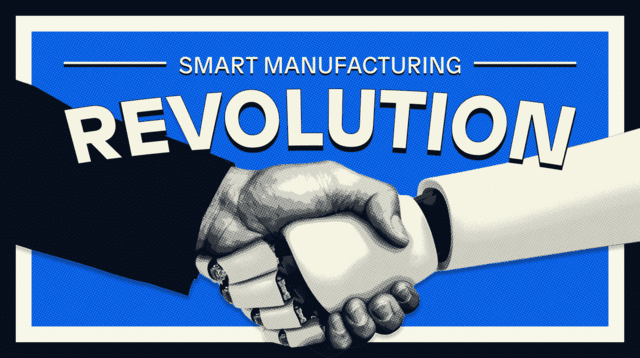How to Ready Your Workforce for the Smart Manufacturing Revolution

Manufacturing workers have always been shoved to the head of the technology learning curve. The Industrial Age essentially started with a factory manager leading some poor shop floor employee over to a belching, bellowing, steam-powered behemoth and saying, “This is the new thing the boss brought in. He says it’ll change everything. Good luck figuring it out. Just be sure to keep your fingers away from the moving bits.”
And so, each generation of manufacturing workers scrambles to catch up to speed on the latest innovation. From steam power to the combustible engine, to electricity to assembly lines, to robotics to computers, every technological revolution has begun with a shop floor worker staring at a new contraption, scratching their head, and muttering, “Ah, how hard can it be?”
Mastering smart manufacturing
For the current generation of shop floor workers, the revolutionary technology they’re tasked with mastering is smart manufacturing. Building on the promises of Industry 4.0 and the Internet of Things (IoT), smart manufacturing technologies seek to connect and optimize data, devices, and processes, equipping factories with hyperflexible, self-adapting capabilities.
Despite their three centuries of serving as the vanguard of industrial evolution, manufacturing workers will have a challenge ahead of them as they find their footing in the new smart factory. As smart manufacturing involves intricate interactions among multiple software systems, there are many technologies to learn and master.
These technologies can include commercial off-the-shelf software for:
- enterprise resource planning
- product lifecycle management
- manufacturing operations management
- warehouse management
- software change management (on the information technology side)
- automation, supervisory control, data acquisition, and IoT-related technologies (on the operational technology side)
They can also include legacy systems still clinging to the edges of the process ecosystem, such as Excel, paper-based processes, or even homebrewed systems whipped up to meet a transient need and then never transitioned out.
Many factories use manufacturing execution systems and manufacturing operation management systems to tie these disparate tools together. But that’s just another layer of technology that manufacturing workers need to gain a grasp of. Their workers having to command this sprawl of systems is making manufacturing leaders nervous. According to a Gartner survey, 57% of them worry that their workforce lacks the skills to support the organization’s smart manufacturing initiatives.
The 3 types of technology users
As they strategize on how to impart the necessary skills to their workforce, manufacturers need to keep in mind the unique needs of three different groups of employees.
The first group is the IT team members charged with implementing and overseeing the factory’s technology systems. This group is the most technologically savvy, but they only make up 10% of the workforce. The second group is the technology end users. They’re the ones putting the technology systems to work, but not making changes to the systems or creating tools to use with the systems. They make up half the workforce.
The remaining 40% is a new tribe of technology users that has been gaining numbers in the manufacturing workforce: the business technologists. These workers don’t have or need the deep software development know-how possessed by the IT team. But they have enough knowledge of and comfort with technology that they can create digital assets—within their domain experience and job responsibilities—to support the organization.
Manufacturers need to keep in mind the needs of all three segments of their workforce while searching for the right skill-building solutions. They should look for solutions that will:
- Simplify the complexity of their technologies
- Unlock and extend coordination and data-sharing between systems
- Unleash the capabilities of the business technologists, while still granting IT firm control of the implementation and use of the organization’s technology portfolio
- Create a network and encourage a culture of employee engagement, creative collaboration, and knowledge sharing
The essential low-code solution
As the perfect solution for readying their workforce for the smart manufacturing revolution, more and more manufacturers are choosing a low-code application development platform like Mendix. A low-code application development platform is the fastest and easiest way to build, integrate, and extend applications. It supports application creation for the web, tablets, augmented reality, and hand-held and vehicle-mounted devices. It can run anywhere: from IT, on the shop floor, in the cloud, and on the edge. It can integrate real-time data from enterprise resource planning, product lifecycle management, manufacturing operations management, warehouse management, and software change management systems. And it can accelerate the convergence of IT and OT processes.
Most importantly, a low-code platform supports and strengthens the skills of your entire workforce. Its intuitive visual interface empowers workers with little to no development experience to connect their data, devices, processes, and tasks with smart manufacturing technologies. And it provides the connectivity and integration ease that allows business technologists to flourish.
By supporting all types of technology users, low-code will simplify your workforce’s adoption of smart manufacturing technology. But smart manufacturing will certainly not be the last of the innovations that will revolutionize manufacturing. New revolutions will no doubt sweep through at increasingly faster intervals. That’s why using a low-code application development platform to keep your processes simple, integrated, and agile, no matter the underlying technology driving them, is only going to become more essential.

